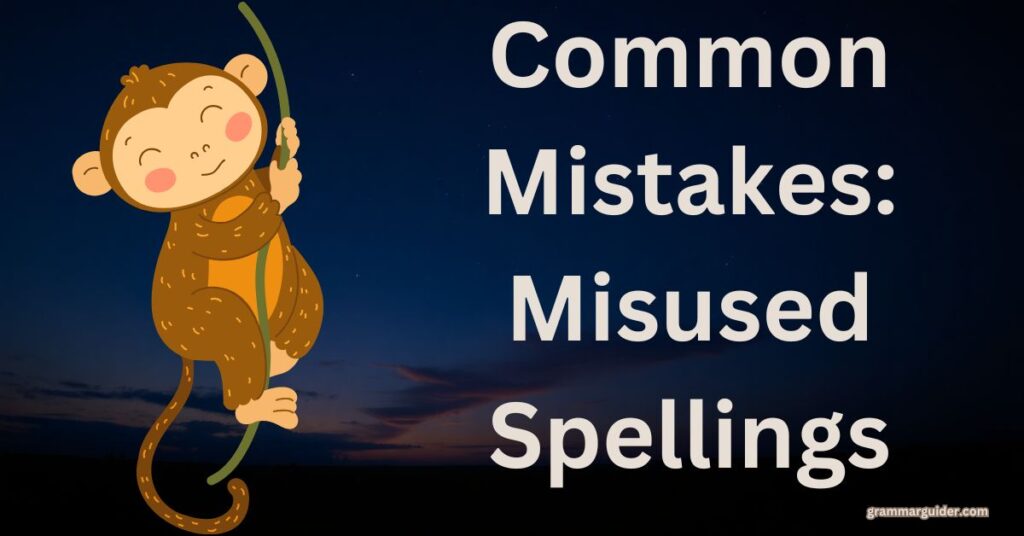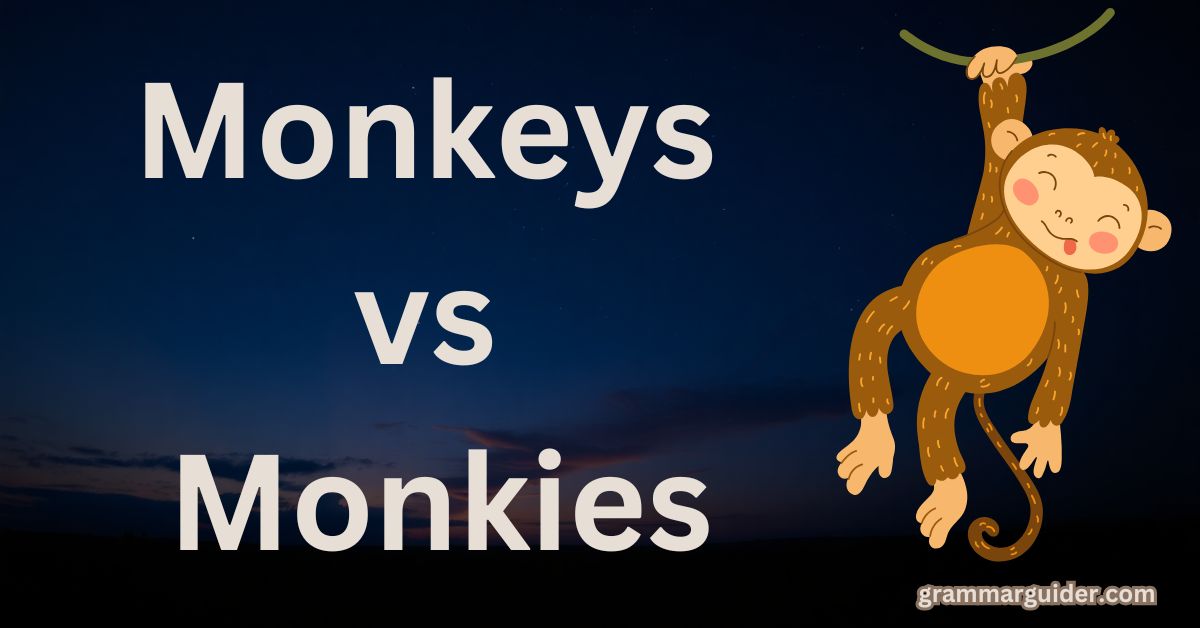When learning English, many people face the challenge of correctly pluralizing words. The English language is notorious for its tricky spelling rules, exceptions, and variations. One of the common areas of confusion involves the plural form of words that end with a “y.” Today, we will dive into the debate of Monkeys vs Monkies, exploring the spelling rules, grammar explanations, and examples to clarify why monkeys is the correct plural form and not monkies.
The Basic Rule: Vowel + Y Rule
To understand why is it monkeys and not monkies, it’s important to grasp the basic rule of pluralization for words ending with a consonant + “y.” According to English grammar rules, the general rule is to drop the “y” and add “ies” when pluralizing such words.
For example:
- City becomes Cities
- Puppy becomes Puppies
- Toy becomes Toys
The rule is simple: when a word ends in a consonant + “y,” change the “y” to “ies” in the plural form.
However, when a word ends in a vowel + y, you simply add “s” to pluralize it. This explains why monkeys is the correct plural form of monkey, and not monkies.
Why Is It Monkeys and Not Monkies?

It’s tempting to think that words like monkey should follow the same pattern as puppy or city, where you just add “ies” to pluralize them.
However, since the word monkey ends in a consonant (the letter “k”) followed by “y,” it adheres to the rule of dropping the “y” and adding “ies”. Therefore, monkeys is the correct plural form.
Many people mistakenly write monkies, but this is a common spelling error. Monkies does not follow the rules of pluralization for words ending in consonant + y. Let’s explore some more examples to solidify this understanding.
Monkeys or Monkies? A Closer Look at Word Endings
The confusion over monkeys vs monkies often arises because people fail to remember the crucial difference between words that end in vowel + y and consonant + y.
In the case of monkey, the word ends with a consonant (“k”) followed by “y,” so it follows the consonant + y pluralization rule.
Here’s a breakdown of the rule:
- Words ending in vowel + y (e.g., toy, bay) only need “s” added to make them plural.
- Words ending in consonant + y (e.g., monkey, puppy) require you to drop the “y” and add “ies” to form the plural.
So, the correct pluralization is monkeys, not monkies.
Examples of Misused Spellings
1. Email Scenario: “Monkeys or Monkies?”
Imagine you’re writing an email to a friend, explaining the correct spelling of the plural of monkey. You might say something like this:
Subject: Monkeys vs Monkies: Which is Correct?
Hi Sarah,
I know we’ve been chatting about monkeys, but I wanted to clear something up. A lot of people mistakenly spell the plural as “monkies”, but that’s not the correct form.
When we’re talking about monkeys, the plural follows the vowel + y rule. Since “monkey” ends with a consonant + “y,” we drop the “y” and add “ies” to make monkeys.
It’s one of those common spelling errors we all make from time to time, but now that we know, we can avoid it!
Hope that clears things up!
Best,
Tom
As you can see, this email illustrates the difference between the correct pluralization and the common mistake of writing “monkies.”
2. Social Media Post: A Fun Example of Plural Forms
Let’s say you’re writing a fun post on social media about your visit to the zoo:
Just saw a bunch of adorable monkeys today! 🐒 Did you know that the plural of “monkey” is monkeys, not “monkies”?! It’s a classic English grammar rule mistake that many people make.
#Monkeys #EnglishLanguageTips #GrammarFun
This post uses the word monkeys correctly while also educating your followers about the common spelling confusion.
Table: Common Pluralization Rules
| Word Ending | Plural Rule | Example |
|---|---|---|
| Vowel + Y (e.g., “toy”) | Add s | Toys |
| Consonant + Y (e.g., “puppy”) | Drop y, add ies | Puppies |
| Consonant + Y (e.g., “monkey”) | Drop y, add ies | Monkeys |
| Vowel + Y (e.g., “bay”) | Add s | Bays |
This table summarizes the pluralization exceptions and helps clarify when to use s and when to use ies.
Common Mistakes: Misused Spellings

Let’s dive into some common spelling mistakes related to monkeys vs monkies and other similar words. Many people often make these errors, which can affect their writing.
- Singular vs Plural Forms: Many learners of English mistakenly use the singular form when they mean the plural. For example:
- Incorrect: “I have three monkies at home.”
- Correct: “I have three monkeys at home.”
- Incorrect Use of “Y”: The confusion of whether to add “ies” or “s” often leads to incorrect forms. Many learners, not knowing the rules, end up writing “monkies” instead of “monkeys.”
- Overlooking Grammar Explanations: The lack of understanding of English language plural forms can lead to confusing spelling mistakes. For example:
- Incorrect: “I love monkies.”
- Correct: “I love monkeys.”
The key to avoiding these mistakes is learning the vowel and consonant rules for pluralization. Once you get familiar with the spelling rules, you will be able to spot common spelling errors more easily.
The Role of Pluralization in English Grammar
Understanding the correct plural spelling is essential for writing and speaking accurately. It is one of the fundamental rules of English grammar, which dictates how words change when you move from singular to plural. Mastering plural nouns like monkeys ensures you communicate clearly and confidently.
English Language Tips for Proper Pluralization
Here are some quick tips to help you avoid spelling mistakes when pluralizing words:
- Always check if the word ends in vowel + y or consonant + y. This is a simple yet effective way to remember the pluralization exceptions.
- Practice common singular vs plural forms with regular exercises. The more you work with these forms, the easier it will be to avoid errors like “monkies” vs “monkeys.”
- Pay attention to pluralization rules when learning new words. For example, “toy” becomes “toys,” while “puppy” becomes “puppies.”
Conclusion: Monkeys or Monkies?
So, is it monkeys or monkies? The correct plural form is monkeys, not monkies. The confusion stems from misunderstanding the rules of vowel + y and consonant + y pluralization. By following the English grammar rules, we can easily avoid these common spelling errors and use the correct plural form in our writing.
Next time you’re talking about a group of adorable monkeys, remember that the correct spelling is monkeys, not monkies!
By understanding the language rules for pluralization and paying attention to spelling, you can make sure that your writing stays clear, correct, and error-free.

Jacob Harrison is the seasoned writer behind Grammar Insights, with over nine years of experience in the field. Passionate about language, he shares practical tips and strategies to help readers enhance their grammar and writing skills. With a friendly approach, Jacob makes learning accessible and enjoyable for everyone.

